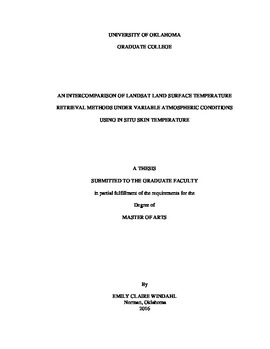| dc.description.abstract | Land surface temperature (LST) retrieved from Landsat is a valuable resource for understanding land cover change, monitoring the urban heat island effect, and modeling hydrological and carbon cycles, among other applications. However, this dataset is underutilized, in part because it is difficult to accurately correct for atmospheric interference, and in part because it is difficult to validate the resulting LST dataset. As a result, it is often challenging to verify the accuracy of LST calculated from historical data. Currently, three correction methods are commonly used to retrieve LST from single-band Landsat TIR data—the radiative transfer equation (RTE), the mono-window algorithm (MWA), and the generalized single-channel (GSC) method. Based on current research, it is often unclear which method is best applied in different circumstances and what the actual achieved accuracy is—especially when these methods are employed as they would be for actual applications, rather than under validation conditions. This study retrieves LST from two years’ worth of clear-sky Landsat 5 TM data using all three methods and validates the results against on-the-ground skin temperature measurements from twenty-five Oklahoma Mesonet stations. Additionally, LST results using both modeled transmittance and transmittance based on precipitable water vapor are assessed, as are results from dates with both high and low precipitable water vapor. Results suggest that the MWA method using modeled transmittance is the most robust, with results statistically indistinguishable from Mesonet skin temperature for the complete dataset and a cloud-free subset, as well as for subsets above and below 2 g/cm^2 precipitable water vapor. The RTE method using modeled atmospheric parameters is also appropriate in some circumstances. | en_US |
